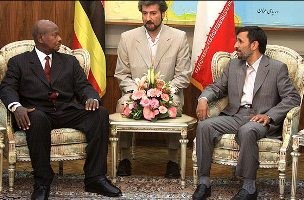Uganda Pursues Energy Sufficiency

The Uganda Government has continued to support petroleum exploration in the Lake Albert and Albertine Grabben area. Investment in this sector was about US $ 500 million as at the end of 2008. Since June 2008, ten additional wells have been drilled. These are at Taitai -1, Ngege – 1, Kaluka – 1, Kasameme – 1, Kingfisher – 2, Kigogole – 1, Ngiri – 1, Jobi – 1, Rii – 1 and Kingfisher – 3. Some of these will have been flow-tested and the remaining ones will be tested in the course of this year.
 |
|
Museveni with Iran President, Ahmedinajad Photo:courtesy |
In 2008, prices of crude oil broke all time record high and hit the US $ 145 per barrel Mark. Within the nation, the challenges of supply constraints when the Kenya pipeline could not deliver sufficient requirements of fuel were significant. Therefore, in order to improve our strategic fuel reserves, the Jinja Storage Tanks (JST) facility will be revamped, upgraded and re-stocked through a public-private partnership. The Jinja Storage Tanks will be integrated into the Kenya-Uganda oil pipeline system that is being constructed. A new large storage facility that will serve all oil companies, will also be built at the pipeline terminal at Nakilembe, West of Kampala.
In addition to the Jinja Storage and Kampala (Nakilembe) Tanks, Government will build in phases four new regional storage facilities in the central, east, north and west of the country, starting in financial year 2010/11. Government will stock those facilities to ensure that the country’s fuel security is assured. The Storage facilities will be linked with the pipeline network to the oil refinery to be constructed near the oil fields in Western Uganda.
With respect to the extension of the Kenya-Uganda Oil pipeline from Eldoret to Kampala, the design and environmental impact assessment have been completed and the required funding for the project has been secured. Construction has started and the extension will be completed in the second half of 2010. If the Kenya Government agrees, the pipeline will be constructed with ability for reverse flow to transport the products of our future refinery in the Lake Mwitanzigye area (L. Albert).
During my address to NEC recently and also in my address to the EU-AU Summit in Lisbon, I pointed out that I cannot accept Uganda to continue being part of the suicidal and rather unserious schemes promoted in Africa. While the kwh per capita of the USA is 14,124, that of Africa today, on average, is 547 kwh. This figure includes South Africa which has got a lot of power. Uganda’s kwh per capita is 60.
In 1986, the total power being generated by Uganda was 60 megawatts. The total installed capacity of electricity generation in Uganda is now 560 megawatts if you include the thermal stations. When Bujagali is finished (250 megawatts), the total installed capacity for the whole country will be 810 megawatts. Even when we add Karuma, the power generated will not be enough to cope with the needs of the population of Uganda which will be 54 million people by 2025. In order to know the amount of power, we need to look at other countries – the First World and Middle income countries. A country like U.K. produces 55,000 megawatts to support its population of 60 million people and its industries.
A country like Malaysia – a middle income one – generates 17,000 megawatts today. If we take the target of a middle income country like Malaysia of 3,330 kwh per capita, you can see that our population of 54 million people by 2025, will need to generate, at least, between 17,000-24,285 megawatts. This must be the minimum we must aim at. As I say, this is a minimum. We, in fact, need much more energy. Therefore, the Ministry of Energy is already directed to develop accelerated power development programmes that will see us use all the sites on the Nile (Ayago, Murchison, etc), all the sites on the small rivers (Bugoye, Muziizi, Kikagate, etc), all the gas and Heavy Fuel potential and all the other sources.
All the rivers in Africa have the hydro-power potential of 456,630 megawatts. This is not enough to power a modernized African society of 1.3 billion people by 2015. The present plans and talk are mere jokes. We need real seriousness. Cheap energy and transport will mean lower costs of doing business in Africa and, therefore, more competitiveness.
H.E Yoweri K. Museveni,
President of Uganda
